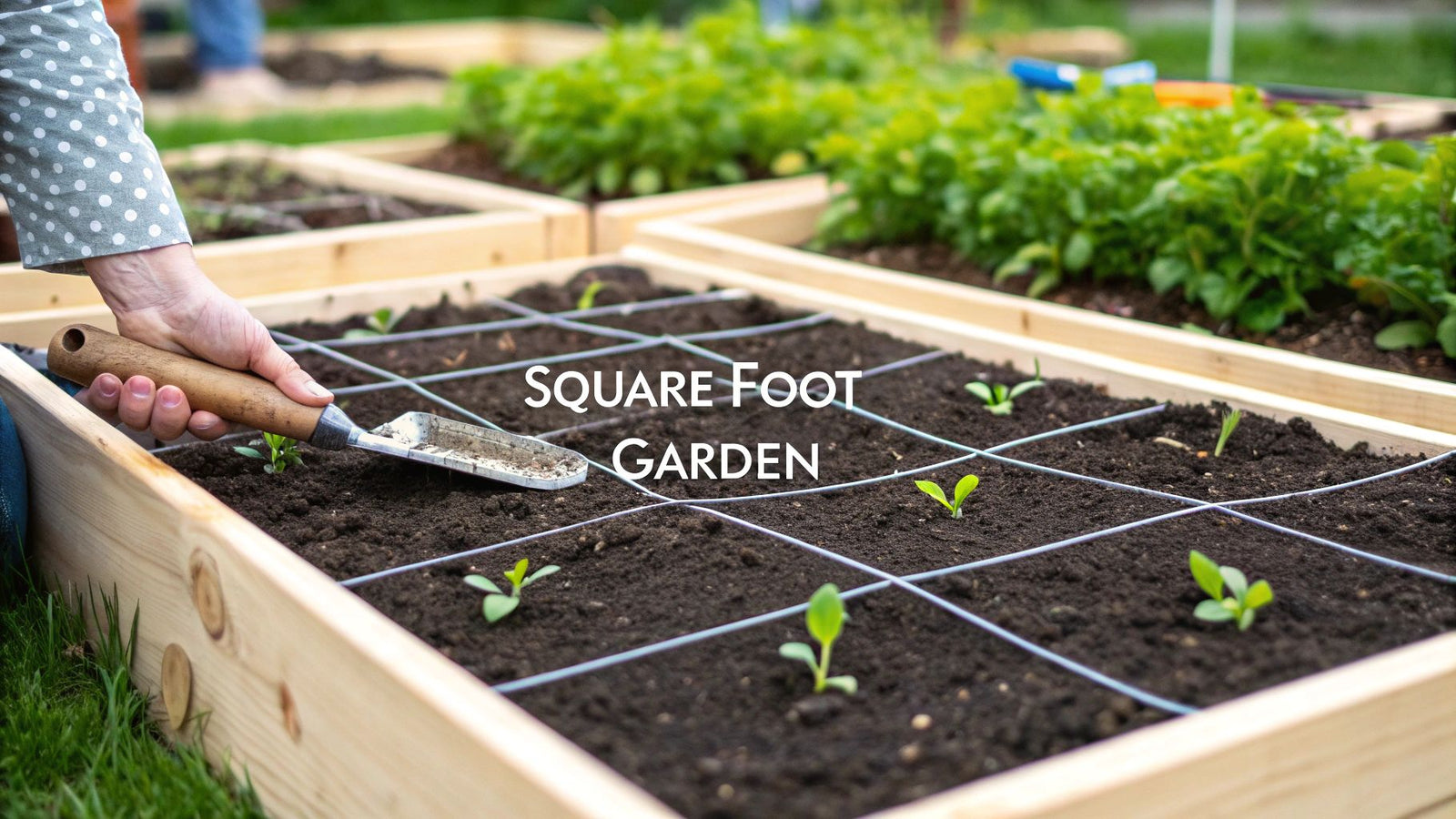
A square foot garden plan is a wonderfully simple system for creating a small but mighty garden. At its core, you're just dividing a raised garden bed into a grid of 1x1 foot squares. This method, made famous by Mel Bartholomew, is all about getting the most out of every inch of soil while putting in less work. It's a strategic way to grow a surprising amount of food with less effort, making it a fantastic starting point for new gardeners or anyone with a small yard.
Why Square Foot Gardening Is Such a Smart Choice
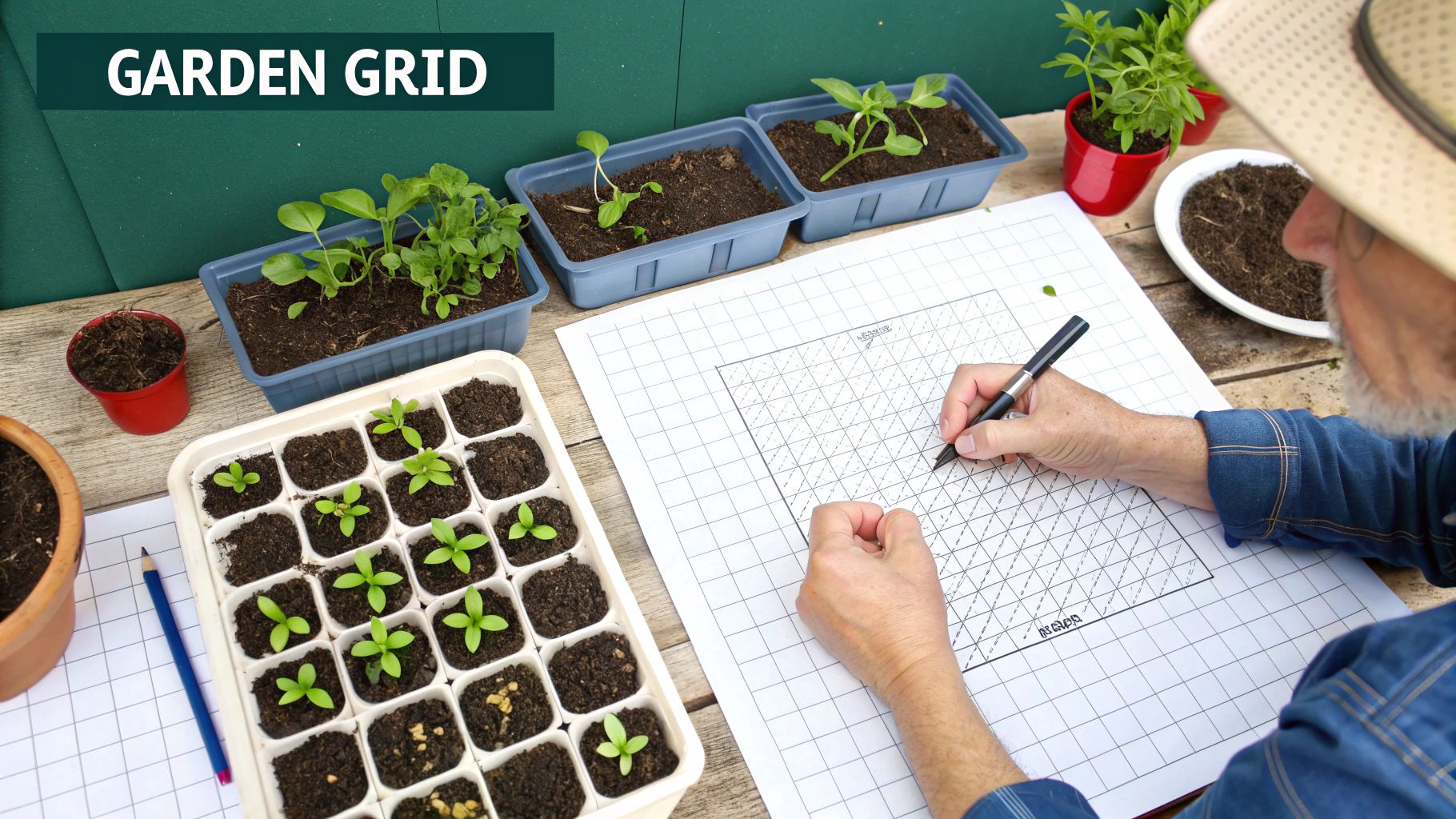
If you've ever looked at a traditional garden and felt a bit overwhelmed, the square foot method might just be the breath of fresh air you need. It completely ditches the old-school thinking of long, wasteful rows and swaps them for a clean, organized grid. But this isn't just about cramming plants into a small space; it's a whole system designed for efficiency.
The main idea is to plant intensively in a compact, easy-to-manage area. When you focus your energy on a smaller plot, the benefits really start to stack up. You'll use far less water, spend almost no time weeding, and have the chance to create the perfect soil mix right from the start. It’s a game-changer, especially for those gardening in cities or suburbs.
Get Bigger Harvests from a Smaller Footprint
Believe it or not, a well-planned square foot garden can produce up to five times more food than a conventional row garden of the same size. Forget planting long rows of seeds only to thin most of them out later. Here, you plant exactly what you need in each square.
For example, you can plant:
- 4 heads of lettuce in one square.
- 16 radishes in another.
- 9 bush bean plants in a third.
This high-density approach ensures every bit of your garden is working for you. If you're ready to map out your own grid, you can dive deeper with our guide on how to start square foot gardening.
It's interesting to see how gardening trends support this. While the average American garden is 600 square feet, the median size is a much smaller 96 square feet. This tells me a lot of people are already embracing these smaller, more intensive gardening styles.
A More Practical Way to Grow Your Own Food
This gardening style has been gaining steam since the 1980s, but it feels more relevant today than ever before. With 72% of city residents now gardening in raised beds and containers, the core principles of square foot gardening perfectly match how people live and grow food now. It's a practical, proven method that just makes sense.
Building Your Garden's Foundation
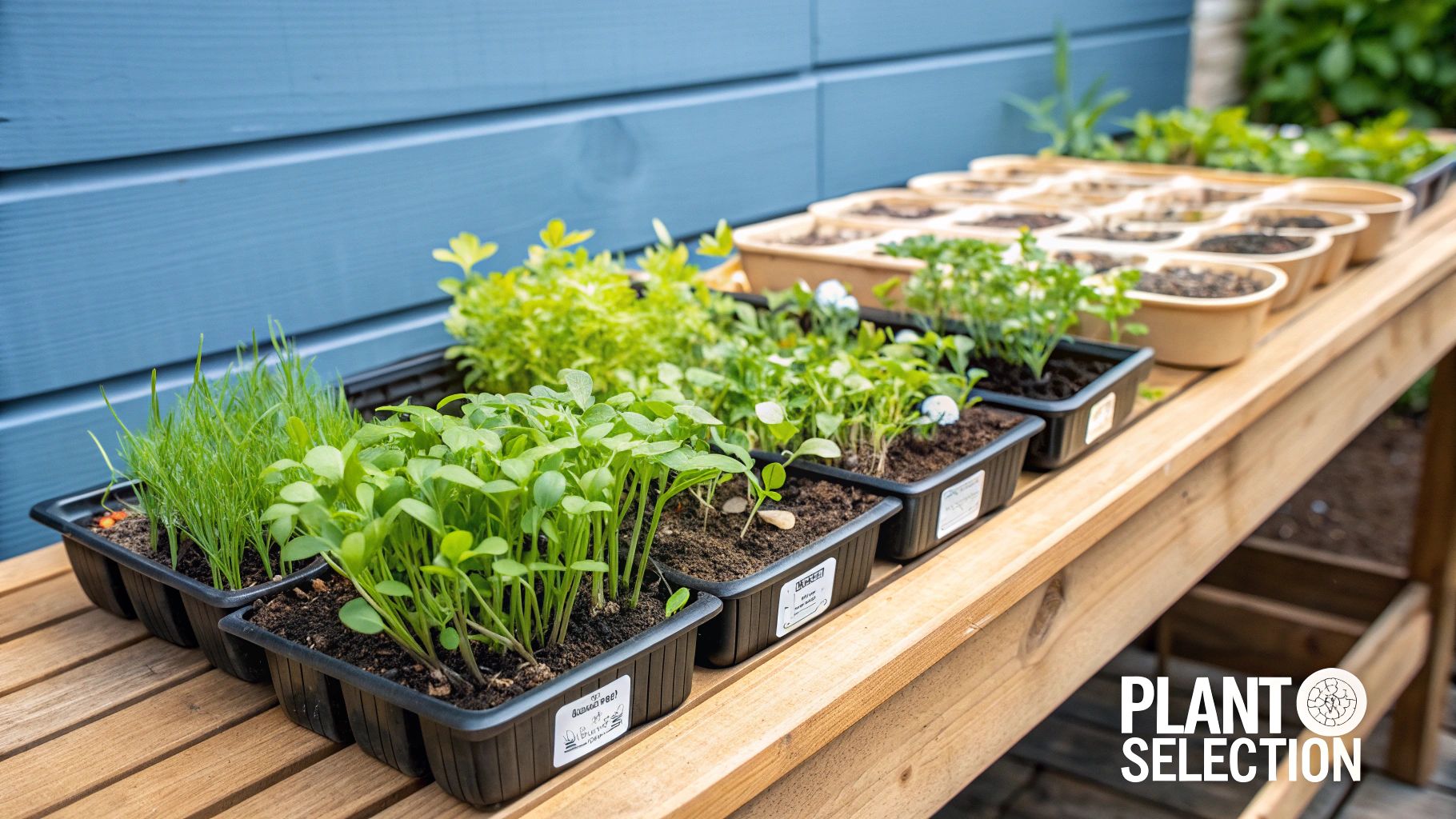
Alright, you've got your garden plan mapped out. Now for the fun part: making it real. Before you start building anything, the most critical decision you'll make is where to put your garden.
Most vegetables and herbs are serious sunbathers, so you'll want to find a spot in your yard that gets at least 6-8 hours of direct sunlight every day. Don't eyeball it! Spend a day tracking the sun's path across your property. This single factor can make or break your harvest.
Once you’ve locked down that perfect sunny patch, it's time to think about the raised bed itself. The materials you pick will determine your garden's look, lifespan, and even your workload down the road.
Choosing Your Bed Materials
There's no single "best" material; it's all about finding the right fit for your budget, your style, and how much maintenance you're willing to do.
- Cedar or Redwood: You can't go wrong with these classic choices. They're naturally beautiful and hold up against rot and bugs for years, no chemical treatments needed. They're my personal favorite for a traditional garden look.
- Composite Wood: If you want something that's practically indestructible, this is it. Made from wood fibers and recycled plastic, composite boards simply don't rot, warp, or splinter.
- Galvanized Steel: For a more modern or industrial vibe, metal beds are a great option. They assemble in a snap, last forever, and have the added benefit of warming up faster in the spring, giving you a slight head start.
A quick word of caution: steer clear of any pressure-treated wood made before 2003, as it might contain arsenic. While newer treated wood is considered safer, I always tell people to stick with naturally rot-resistant options when growing food. It's just better for peace of mind.
Why You Can't Skip the Grid
The final, non-negotiable piece of the structure is the grid. This simple 1x1 foot lattice is the heart and soul of the square foot gardening method. It’s what gives you that perfect plant spacing and turns a regular box into a super-productive, organized garden.
I see people tempted to skip the grid to save a few minutes, and I always tell them the same thing: don't do it! The grid is your roadmap. It takes all the guesswork out of planting and makes it incredibly easy to see and manage each square. It’s the secret sauce.
You can easily make your grid from thin wood lath, sturdy twine pulled taut, or even repurposed vinyl window blinds. Simply lay it over the top of your soil, and you're officially ready to create the perfect soil mix for your new garden.
Creating the Perfect Soil for Maximum Growth
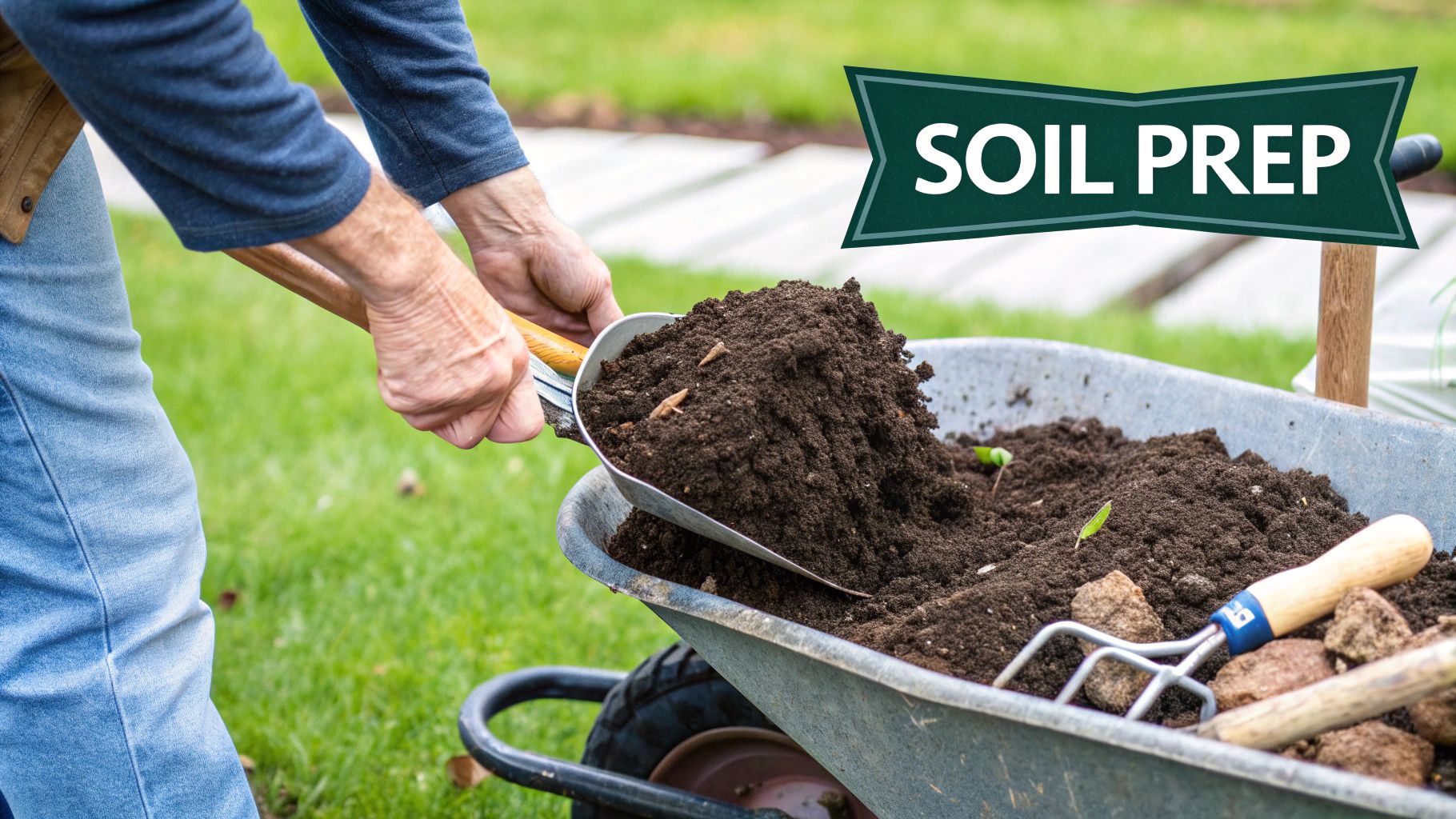
The real secret to a wildly productive square foot garden isn't some complex technique—it's what's in the box. The soil. Forget wrestling with heavy, clay-filled yard dirt that can be a real headache. For this method, we create a special, lightweight blend from scratch that gives your plants the perfect foundation to thrive.
This is where your garden plan truly begins to come to life. The classic recipe, famously known as "Mel's Mix," is a thing of beauty because it's both simple and incredibly effective. You can easily whip up a batch in a wheelbarrow or on a tarp.
The Perfect Soil Recipe
The magic formula is a balanced, equal-parts blend. Think of it as a three-part harmony where each ingredient plays a crucial role.
- One-third blended compost: This is the powerhouse of your mix. Using compost from several different sources (like mushroom compost, cow manure, and your own home compost) provides a broad spectrum of nutrients to feed your plants all season.
- One-third peat moss or coco coir: This ingredient acts like a sponge. It’s fantastic at retaining moisture, which means your plant roots get a steady supply of water without ever sitting in a soggy mess.
- One-third coarse vermiculite: This is what keeps your soil light and airy. These little mineral flakes prevent the soil from compacting, giving roots the space and oxygen they need to grow strong and deep.
This specific combination creates a soil that’s fluffy, packed with nutrients, and holds water beautifully. It's the ideal environment for a high-density square foot garden because it encourages massive root growth in a small space. For a deeper dive, check out our complete guide on preparing garden soil for planting.
Making your own soil also puts you in complete control, which fits perfectly with today’s more sustainable gardening trends. In fact, a National Wildlife Federation survey revealed that one in three (32%) American gardeners now actively seek out organic products. By building your own soil, you know exactly what’s going into it. You can learn more about this shift toward eco-friendly practices in the latest gardening market research.
Crafting Your High-Yield Planting Map
Alright, this is where the real fun begins. You've built your bed and mixed your soil, and now it's time to shift from gardener to garden designer. We're about to create a living, edible mosaic, and the beauty of square foot gardening is just how simple the "rules" are.
The entire system boils down to one core idea: how many of a specific plant can you fit into a single 1x1 foot square? It’s a total game-changer compared to old-school row gardening. Forget thinking in long, wasteful lines; we’re thinking in productive little blocks.
The Basic Spacing Guidelines
How many plants go in each square depends entirely on how big the plant gets when it's fully grown. A single, sprawling tomato plant obviously needs a lot more room than a handful of radishes. Your final garden map will be a mix of these different densities.
Here’s the breakdown I use:
- 1 Plant Per Square: This is for the big guys. Think tomatoes, peppers, broccoli, cabbage, and kale. They need the whole square to themselves to really stretch out and soak up the sun.
- 4 Plants Per Square: Perfect for medium-sized leafy greens and herbs. I use this for leaf lettuce, Swiss chard, and big basil plants. Just imagine your square divided into four smaller quadrants and pop one plant in each.
- 9 Plants Per Square: This is my go-to spacing for bush beans, spinach, and beets. Picture a tic-tac-toe grid inside your square—a plant goes right in the middle of each of those nine spots.
- 16 Plants Per Square: Reserved for the smallest and quickest crops. Radishes, carrots, and scallions fit perfectly here. You’ll have four neat little rows of four plants each.
This visual really helps tie it all together, showing how you can map out these different groupings across your garden bed.
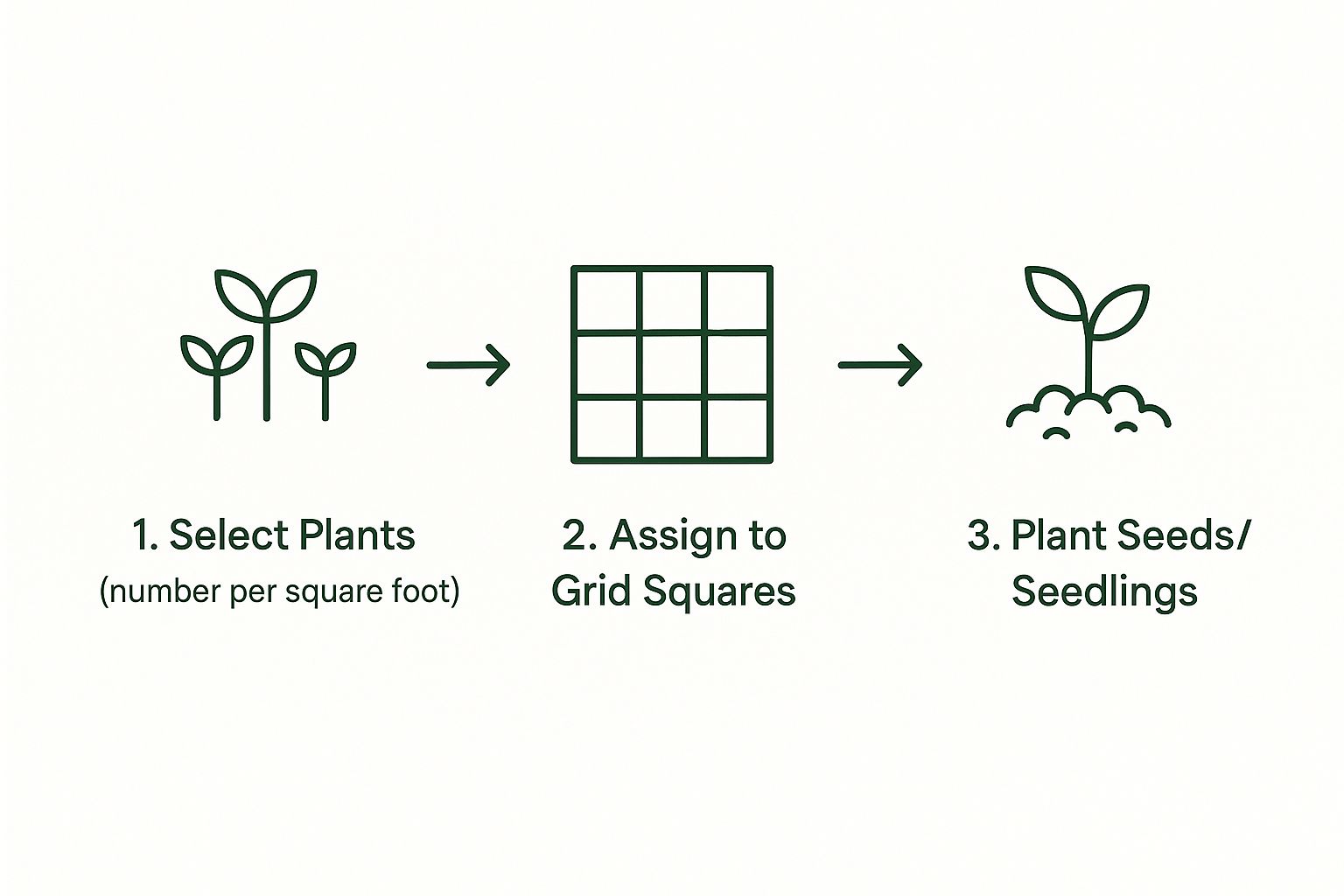
As you can see, it's a straightforward process of picking your plants and then penciling them into the grid based on how much space they need.
To make this even easier, here’s a quick-reference table you can use to map out your own garden. It shows you exactly how many plants fit into each square for some of the most common garden vegetables and herbs.
Plant Spacing Guide for Your Square Foot Garden
| Plants per Square Foot | Example Vegetables & Herbs |
|---|---|
| 1 | Tomato, Pepper, Broccoli, Cabbage, Kale, Eggplant, Cauliflower, Head Lettuce |
| 4 | Leaf Lettuce, Swiss Chard, Basil, Parsley, Marigold, Arugula |
| 8-9 | Bush Beans, Spinach, Beets, Peas, Turnips, Cilantro, Garlic |
| 16 | Carrots, Radishes, Green Onions (Scallions), Onions (from sets) |
Use this guide as your cheat sheet when you're sketching out your plan. It takes the guesswork out of spacing and helps ensure your plants have enough room to thrive without getting overcrowded.
Smart Planting Strategies
A truly great garden plan goes beyond just the numbers. Strategic placement can create a healthier, more productive little ecosystem. This is where you can get creative and make that small space work even harder for you.
One of my favorite techniques is companion planting, which is just a fancy way of saying you put plants together that help each other out. Planting marigolds in a square next to your tomatoes, for instance, can help ward off nasty pests. Some gardeners swear that planting basil nearby makes tomatoes taste even better. For a deeper dive into these powerful plant friendships, check out our guide on which vegetable seeds go well together.
Here’s another pro tip: Think vertically! Don't let the edges of the box be your only limit. Vining plants like cucumbers, pole beans, and some types of squash can be trained up a trellis. I usually place my trellis along the north side of the bed so it doesn't cast a shadow on smaller plants. This trick saves a ton of space and dramatically improves air circulation, which is key to preventing mildew and other fungal diseases.
Mastering a Continuous Harvest All Season
A great garden plan isn't just about one big harvest. The real magic is getting a steady stream of fresh food from early spring all the way to the first frost. This is where a technique called succession planting comes into play.
It’s a simple but incredibly effective idea. As soon as you pull a crop out of one square, you put something new right back in its place. For instance, after you harvest your fast-growing radishes (16 per square) in late spring, that spot doesn’t go to waste. You can immediately sow some heat-tolerant bush beans (9 per square) to thrive through the summer months. This keeps every inch of your garden productive all season long.
Smart Rotation and Scheduling
To pull this off, you just need a basic schedule that cycles through cool-season and warm-season plants. I like to think about the gardening year in a few distinct phases.
- Early Spring: This is prime time for crops that love cool weather. Get your squares filled with things like spinach, lettuce, radishes, and peas. You can often plant these a few weeks before your last expected frost.
- Late Spring to Early Summer: As you harvest those early crops, the soil is ready for warm-weather stars. This is when you’ll plant tomatoes, peppers, bush beans, and basil.
- Late Summer into Fall: Once the summer heat mellows and those plants are done, it's time for another round of cool-season favorites. You can plant more lettuce, spinach, and even carrots for a wonderful autumn harvest.
By constantly swapping out different types of plants, you're also practicing a simple form of crop rotation. This naturally helps break up pest and disease cycles, leading to healthier soil without even trying.
This intensive approach really maximizes what you can grow. A well-managed square foot garden can already yield up to five times more than a traditional row garden. The financial benefit is just as impressive. In 2024, American food gardeners estimated they saved an average of $875 by growing their own produce. You can dig deeper into these numbers with these food garden trends and statistics.
Unpacking Common Square Foot Gardening Questions
Even with a solid plan, a few questions always pop up when you're starting something new. It's totally normal. Let's tackle some of the most common things new square foot gardeners ask, so you can get your hands dirty with confidence.
How Deep Should My Garden Bed Be?
This is probably the number one question I get. For the vast majority of your vegetables and herbs—think lettuce, basil, peppers, and bush beans—a depth of 6 to 8 inches is perfect. This is especially true when you're using that fluffy, nutrient-packed soil mix we recommend.
However, if you're dreaming of harvesting your own long, straight carrots or parsnips, you'll want to give them more room to stretch out. For deep root crops like those, aim for a bed that's at least 12 inches deep.
Can I Just Use My Yard Soil?
It's tempting to save a step and just scoop soil from your yard, but trust me on this one: don't do it. Your native garden soil is usually way too heavy and compact for this method. It can choke out delicate roots and often comes packed with weed seeds and potential diseases you'd rather not deal with.
The real magic of square foot gardening is in the special soil mix. It’s lightweight, drains beautifully, and is full of the good stuff plants need to thrive right from the start.
What Are the Easiest Plants to Start With?
Feeling a little overwhelmed by the seed catalog? I get it. Here are a few can't-miss options to get you started and build your confidence:
- Leafy Greens: You can't go wrong with loose-leaf lettuce (4 per square) or spinach (9 per square). They grow fast and give you continuous harvests.
- Quick Wins: Radishes (16 per square) are incredibly satisfying because they mature so quickly. They're a perfect first harvest.
- Simple & Productive: Bush beans (9 per square) are wonderfully low-maintenance and produce a ton of beans in a small space.
A quick tip on watering: Always aim your watering can or hose at the base of the plants, right on the soil. Overhead sprinkling can encourage fungal diseases on the leaves. Getting water straight to the roots is far more efficient and keeps your plants healthier.
That special soil mix is also fantastic at holding moisture, which means you'll probably water less than you would with a traditional row garden. The best way to know when it's time? Just stick your finger about an inch or two into the soil. If it feels dry, it's time for a drink.
At Homegrown Garden, we have all the high-quality heirloom seeds and expert advice you need to get your garden growing strong. Take a look at our seed collection and start planning your perfect plot at https://www.homegrown-garden.com.



